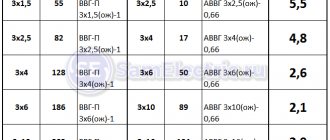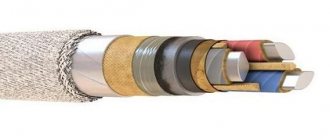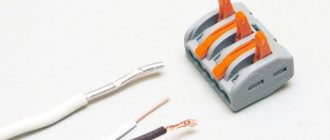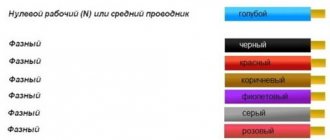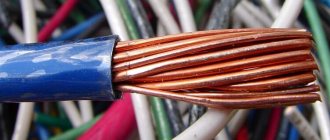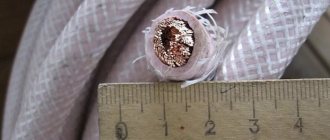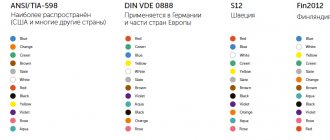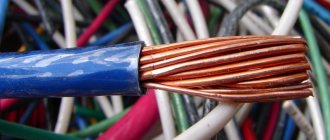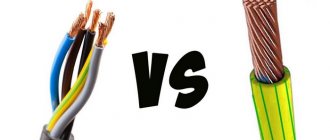Cable and wire products include a variety of types of wires that are designed to solve electrical problems. Moreover, when performing household electrical installation work, it is customary to use either aluminum or copper wire. Other materials are not popular. If there are no restrictions on weight and cost, then it is better to use copper products. But copper has a significant drawback - it oxidizes in the open air, which often leads to deterioration of contact. As a result, the junction begins to conduct electric current less and less well, a voltage drop occurs, the connection heats up more and more, and over time the electrical wiring may catch fire.
Therefore, to prevent short circuits and ensure a safe connection, it is better to use aluminum wiring.
Of course, aluminum also has its drawbacks. Its conductivity is 1.5 times lower than that of copper.
Why aluminum
Although aluminum conductors do not have high performance characteristics, they do:
- cheap compared to copper;
- are light in weight. Thus, aluminum wire is 3 times lighter than copper;
- universal in use - the operating temperature range is quite wide from –50 ⁰С to +50 ⁰С;
- resistant to high humidity - up to 98%;
- resistant to corrosion damage. Although there are nuances here too: the surface of any aluminum product in air is instantly susceptible to oxidation and is immediately covered with a film that protects the wire from further oxidation.
It would seem that it is more profitable to use aluminum products than copper ones. But she also has a number of negative qualities. Thus, the disadvantages of aluminum conductors are the low mechanical strength of the material, and the connection of such wires causes problems in the passage of current through them. Besides:
- the conductivity of aluminum is not high enough - 0.0271 Ohm×mm²/m;
- aluminum is susceptible to oxidation, and its film, which appears after it, does not conduct electricity well. But here, too, there is a catch: this film consists of particles of the upper layer of the conductor itself, which separates from the overall structure and thereby reduces its diameter. As a result, the initial resistance characteristic of aluminum wire increases;
- Due to the increased resistance of the film on aluminum wiring in the places where its individual parts are connected, the contact resistance increases, which causes the wiring to heat up. Therefore, if the service life of the aluminum wires used is exceeded, this may lead to a fire;
- Aluminum is not elastic and very brittle. Moreover, fragility increases after overheating.
Whether to use aluminum or copper wires depends on the tasks and priorities.
Application of aluminum wires
The most popular brands of aluminum wires are SIP and AVVG.
The AVVG universal power cable can be used under any conditions, sudden temperature changes and high humidity levels - up to 98%. This is a cable with aluminum conductors and polyvinyl chloride insulation that is quite tensile strength and resistant to aggressive environments.
Such wires are intended for stationary single electrical wiring installations that will not be subject to significant mechanical loads, for example:
- in open areas where the impact of climatic factors is maximum;
- in voids that are located in building structures;
- in basements and rooms that are subject to flooding;
- rarely underground.
Such wires can be used for operation in systems where the voltage passes no more than 660 V, and for conductors with a core cross-section of more than 50 mm, use in networks that carry a voltage of 1000 V is permissible.
The marking of aluminum SIP wires means that they are intended to provide and distribute electricity in overhead power lines and in lighting electrical networks with voltages up to 35 kV. They can be used as an alternative to traditional bare wires because they have an insulating layer of polyethylene. The advantages of SIP include the following properties:
- prevent the risk of overlapping and twisting of wires, which is typical for uninsulated lines;
- help reduce the width of the clearing, and when laying electrical lines in the city, they do not require the allocation of a large right-of-way of land;
- reduce operating costs by up to 80%;
- eliminate the risks of illegal connection and theft of electricity.
Wire groups by type
All conductors are divided into 2 large groups:
- Single-core wires consisting of one current-carrying core. This category of monolithic wires is characterized by rigidity, so craftsmen recommend using single-core wires when laying stationary wiring that will not be transferred anywhere.
- Stranded wires consist of 7 or more thin wires, neatly woven together into one large rope. A photo of stranded wires clearly demonstrates the difference between a pigtail cable and a single-core wire. The number of current-carrying cores is determined by TU or GOST (depending on the scope of application of the stranded wire and operating conditions). Rubber threads are often woven into stranded wires to increase the elasticity of the wiring.
For example, overhead power lines are installed only from multi-core wires. At the same time, single-core cable wires are actively used when laying highways underground, where the cable will not be exposed to external factors and vibration, and in the construction of cars.
For home wiring, both single-core and multi-core cables are suitable. Electricians often use single-core cable when installing hidden wiring in a home. Laying a multi-core main will require the installation of cable ducts, which will inevitably lead to additional costs.
Rules for using aluminum wires
Based on the above, aluminum conductors are not considered the most optimal for laying wiring in residential buildings. But their use is possible subject to the following rules:
- if it is necessary to connect aluminum wires, then it is necessary to use exclusively a mechanical method, clamping contacts and a lubricant specially designed for this, which will reduce the likelihood of contact oxidation;
- do not connect aluminum wiring directly to copper wiring;
- periodically tighten the screw connections - during operation, aluminum begins to “leak” from under the clamping point, and this can lead to a decrease in the contact area and burning of the places where the wires are connected;
- monitor service life.
If you plan to change the copper electrical wiring in the house and install aluminum, but not in all rooms, but partially, then know that this can be done, but subject to some nuances:
- PUE prohibits the use of aluminum wire with a diameter of less than 16 mm² during installation;
- Welding of aluminum wires is not permitted.
Methods for connecting stranded wires
When laying electrical wiring, the question always arises: how to connect multi-core wires into one large network?
The most common methods of connecting multi-core lines:
- It is not easy to connect multi-core cables with screw terminals, since some wires will constantly be knocked out from under the screw.
- Welding is equally suitable for all types of wires, but multi-core contacts can be damaged if the device is handled carelessly. Broken or deformed core elements will impair connection and conductivity.
- The pressing is ideal for multi-core wires.
- For soldering, flexible stranded wires are preferable, since the wire has to be bent during the process.
How to properly connect aluminum wires
Taking into account the advantages and disadvantages of this type of conductor products, it is customary to use screw or spring clamps when connecting them.
Before connecting aluminum wires using screw terminals, it is recommended:
- clear their ends from the insulating coating by 2 cm;
- clean them with fine-grained sandpaper;
- twist the bare ends into a ring with a diameter slightly larger than the diameter of the clamping screw;
- put the resulting loop on the clamping screw and screw it in as far as it will go.
The disadvantage of this connection method is that due to the leaking property of aluminum, the screws will have to be constantly tightened, so they must be easily accessible.
In the case of using the spring connection method, it is necessary to insert the pre-stripped cores into special terminal blocks. This will avoid re-tightening the contacts, since they will be securely fixed by the spring located inside the terminal block.
Twisting of aluminum wires is not allowed by the rules of electrical installations (PUE).
Choice of insulation
Insulation plays an important role in protecting users from electric shock. At the same time, the insulating layer reliably protects the wire core from premature deformation and other external influences.
High-quality external insulation materials increase the flexibility of the line, maintaining strength throughout the entire service life of the wires.
Among the most common insulating materials, it should be noted:
- PVC - withstands temperature fluctuations, keeping the cores in working condition. Shows high resistance to chemicals, the environment, acid, and moisture. Among the disadvantages is the appearance of fragility with prolonged exposure to ultraviolet rays.
- Cross-linked polyethylene insulation material is highly resistant. Vulcanized polyethylene can withstand critical elevated temperatures.
- Rubber insulating surfaces make the cable flexible, but over time the wires become brittle. At high temperatures the insulating layer melts.
- Fluoroplastic is a unique insulating coating for multi-core wires. The material makes the product resistant to any impact, although the flexibility of fluoroplastic wires is very low.
When installing multi-core wires, it is worth calculating the load on the network, choosing the correct cable cross-section, as well as materials. High-quality wiring will last a long time and without incident.
Connecting aluminum and copper wires: what are the risks?
Sometimes it happens that when laying aluminum wires it is not possible to avoid connecting with copper wires. But, as you know, direct contact connection of copper and aluminum in electrical wiring is not recommended and even dangerous. What to do?
It is impossible to twist wires made of two different metals together, because aluminum and copper differ in their properties, chemical structure, and current conductivity, and the resistivity of an aluminum wire differs from that of a copper wire.
This also applies to the protective film that forms after oxidation: on copper products it conducts electric current, but on aluminum the film has such a strong resistance that it practically does not allow current to pass through and, accordingly, is practically resistant to heating. And after heating and cooling occurs several times in a row at the junction of copper and aluminum wires, they are greatly weakened, which can lead to overheating, sparking and even fire.
Also, in places where copper and aluminum wiring are connected, a galvanic couple can occur. It causes dissociation of the oxides of electrical conductors, contributes to the destruction of the metal structure and the formation of voids and cavities in it, which in turn contribute to a reduction in their cross-section and a deterioration in their ability to pass electric current.
In a word, the connection of aluminum conductors with copper leads to electrocorrosion of the metal and its destruction.
But if you need to connect different wires, then in this case you should not use soldering of aluminum and copper wires, but bolted connections and terminals. Thanks to this, higher security can be achieved than using the conventional twisting method.
Aluminum wire extension: what is it and when is it used?
When carrying out electrical installation work, incidents and difficulties occur: the wire may break on its own due to “old age,” the wall was accidentally cut while drilling, the length was not calculated, and so on. What to do in such situations? The solution to these problems is to build or extend the wire.
How to extend aluminum wire correctly? To do this, there are several ways to lengthen a rather fragile aluminum wire:
- the use of a special heat-shrinkable tube, which is placed on the ends of the wires;
- extension using a block;
- connecting aluminum wires to each other using an aluminum spiral followed by insulation.
If you are using aluminum electrical wiring that is 20–30 years old, using the method of lengthening it becomes unsafe, because in the age of using powerful electrical appliances, the risk of fire increases.
Where can I buy
You can purchase the wire as quickly as possible at your nearest specialized store. The optimal option, in terms of price-quality ratio, remains purchasing from the AliExpress online store. Mandatory long waits for parcels from China are a thing of the past, because now many goods are in intermediate warehouses in destination countries: for example, when ordering, you can select the “Delivery from the Russian Federation” option:
| 100m 1.0mm 18 silver anodized aluminum wire | Aluminum wire 99.99% high purity | Aluminum Wire Keyue AWS A5.10 ER4043 |
| Colored Aluminum Wire 1mm, 1.5mm, 2mm, 2.5in | Aluminum Flux Cored Welding Wire | 1.6mm 2.0mm Universal Copper Aluminum Welding Electrodes |
How to calculate cable cross-section
The cross-sectional area of the wires is standardized, so the cable parameters are selected based on the current values, taking into account the material of the core and its operating conditions.
Wires laid together in a single tray will heat up when operating at maximum, reducing the permissible current by a third.
- When calculating the cross-section of wires, it is important to consider that per 1 sq. mm of copper wire the maximum load should not exceed 10 A.
- For the aluminum analogue, the figures drop to 8 A.
- To calculate the cross-section of multi-core wires for home wiring, you need to divide the total value of all electrical appliances in the network (indicators taken from technical documentation) by the standard network voltage of 220V.
- However, professional electricians recommend using stranded wires with a cross-section of 4 square meters or more for open wiring in a country house. mm.

